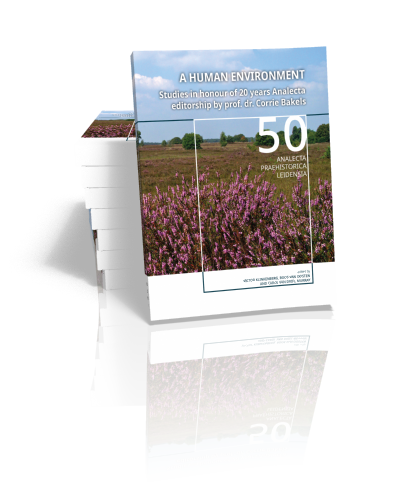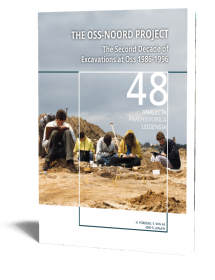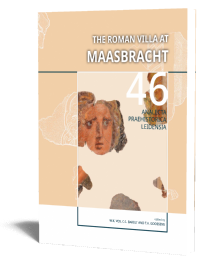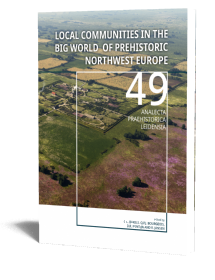A Human Environment
Studies in honour of 20 years Analecta editorship by prof. dr. Corrie Bakels
Edited by Victor Klinkenberg, Roos van Oosten & Carol van Driel-Murray | 2020

A Human Environment
Studies in honour of 20 years Analecta editorship by prof. dr. Corrie Bakels
Edited by Victor Klinkenberg, Roos van Oosten & Carol van Driel-Murray | 2020
Paperback ISBN: 9789088909061 | Hardback ISBN: 9789088909078 | Imprint: Sidestone Press | Format: 210x265mm | 196 pp. | Analecta Praehistorica Leidensia 50 | Series: Analecta | Language: English | 21 illus. (bw) | 60 illus. (fc) | Keywords: environmental archaeology; landscape archaeology; bioarchaeology; landscape dynamics; prehistory; middle ages; ecology | download cover
Read online or downloaded 1664 times
-
Digital & Online access
This is a full Open Access publication, click below to buy in print, browse, or download for free.
-
Buy via Sidestone (EU & UK)
-
Buy via our Distributors (WORLD)
For non-EU or UK destinations you can buy our books via our international distributors. Although prices may vary this will ensure speedy delivery and reduction in shipping costs or import tax. But you can also order with us directly via the module above.
UK international distributor
USA international distributor
-
Bookinfo
Paperback ISBN: 9789088909061 | Hardback ISBN: 9789088909078 | Imprint: Sidestone Press | Format: 210x265mm | 196 pp. | Analecta Praehistorica Leidensia 50 | Series: Analecta | Language: English | 21 illus. (bw) | 60 illus. (fc) | Keywords: environmental archaeology; landscape archaeology; bioarchaeology; landscape dynamics; prehistory; middle ages; ecology | download cover
Read online or downloaded 1664 times

We will plant a tree for each order containing a paperback or hardback book via OneTreePlanted.org.
This volume is themed around the interdependent relationship between humans and the environment, an important topic in the work of Corrie Bakels. How do environmental constraints and opportunities influence human behaviour and what is the human impact on the ecology and appearance of the landscape? And what can archaeological knowledge contribute to the current discussions about the use, arrangement and depletion of our (local) environment?
Editorial
A life dedicated to science. Portrait of professor emerita Corrie Bakels, pioneer of paleoeconomy
Monique van den Dries and Harry Fokkens
The Middle Palaeolithic site Lingjing (Xuchang, Henan, China): preliminary new results
Thijs van Kolfschoten, Zhanyang Li, Hua Wang and Luc Doyon
Neandertal advice for improving your tinder profile: A pilot study using experimental archaeology to test the usefulness of manganese dioxide (MnO2) in Palaeolithic fire-making
Andrew C. Sorensen
Landscape dynamics near the late Middle Palaeolithic and Early Upper Palaeolithic cave site of Les Cottés (France)
Joanne Mol, Lars den Boef and Marie Soressi
Een ziltige geur – halophytic macroscopic plant remains from Happisburgh Site 1, UK indicating Middle Pleistocene hominin activity in an estuary prior to the Anglian Stage (MIS 12) ice advance
Michael H. Field
Palaeoenvironment and human occupation patterns: a case study for the first half of the Holocene at Cova Fosca (Eastern Spain)
Laura Llorente-Rodríguez, Arturo Morales-Muñiz, María-Teresa Aparicio, Salvador Bailón, Paloma Sevilla and Carmen Sesé
Exploring the archaeological heritage of the Uddeler Heegde: an experiment
Alexander Verpoorte, David Fontijn and Arjan Louwen
Walking and marking the desert: Geoglyphs in arid South America
Karsten Lambers
Pre-Hispanic and contemporary raw materials use in earthenware production in the Río Mayales subbasin, Chontales, central Nicaragua
Simone Casale, Natalia R. Donner, Dennis Braekmans and Alexander Geurds
A long slow goodbye – Re-examining the Mesolithic – Neolithic transition (5500 – 2500 BCE) in the Dutch delta
Gerrit L. Dusseldorp and Luc W.S.W. Amkreutz
House Societies or societies with houses? Bandkeramik kinship and settlement structure from a Dutch perspective
Ivo M. van Wijk and Pieter van de Velde
Reflections on an Environmental History of Resistance: State Space and Shatter Zones in Late Antique North Africa
Jip Barreveld
Fiery forest management: an anthracological approach on the charred remains of medieval Noord-Brabant in Tilburg-Udenhout-Den Bogerd
Erica van Hees, Jorinde Pijnnaken-Vroeijenstijn and Marleen van Zon
Mysterious medieval manure pits: an indication of urban horticulture?
Roos van Oosten, Sander Aerts, Jantine Hos and Erica van Hees

Dr. Victor Klinkenberg
Victor Klinkenberg is post-doctoral fellow at the Archaeological Research Unit of the University of Cyprus. He investigates social structures in the past through the analysis of the construction and use of domestic space. He specializes in techniques from digital archaeology (3D GIS, spatial analysis) and geoarchaeology (micromorphology). His PhD was on reconstructing activities at the LBA settlement at Tell Sabi Abyad, Syria, part of the ERC project Consolidating Empire (dunnu.nl). Afterwards he held a post-doc research position, and a lectureship teaching in the BA and MA Archaeology at Leiden University.

Dr. Roos van Oosten
Roos van Oosten is universitair docent stadsarcheologie aan de Universiteit Leiden. Naast het verzorgen van onderwijs verricht zij momenteel onderzoek in het kader van haar Veni-project ‘Challenging the paradigm of filthy and unhealthy medieval towns’.
—
Roos van Oosten began her academic career studying medieval history after which she began her archaeological degree that culminated in a thesis on urban archaeology. Her PhD dissertation at the University of Groningen focused on sanitation management, which she successfully defended in 2014. In 2011 she was appointed as university lecturer in urban archaeology at Leiden University.
Dr. Carol van Driel-Murray
Carol van Driel-Murray (1950) obtained her PhD in 1987 at the University of Amsterdam on the subject of Roman Leatherwork. She taught the Archaeology of the Roman Provinces at University of Amsterdam till 2012, and at the Faculty of Archaeology at Leiden University till her retirement in 2015. She has published extensively on Roman military leatherwork, Roman and medieval footwear. Her research interests include gender in material culture, military communities and military equipment. She participated in various excavations in Syria, and has been involved with the Jebel Aruda campaigns and publication from its inception.
Abstract:
This volume is themed around the interdependent relationship between humans and the environment, an important topic in the work of Corrie Bakels. How do environmental constraints and opportunities influence human behaviour and what is the human impact on the ecology and appearance of the landscape? And what can archaeological knowledge contribute to the current discussions about the use, arrangement and depletion of our (local) environment?
Contents
Editorial
A life dedicated to science. Portrait of professor emerita Corrie Bakels, pioneer of paleoeconomy
Monique van den Dries and Harry Fokkens
The Middle Palaeolithic site Lingjing (Xuchang, Henan, China): preliminary new results
Thijs van Kolfschoten, Zhanyang Li, Hua Wang and Luc Doyon
Neandertal advice for improving your tinder profile: A pilot study using experimental archaeology to test the usefulness of manganese dioxide (MnO2) in Palaeolithic fire-making
Andrew C. Sorensen
Landscape dynamics near the late Middle Palaeolithic and Early Upper Palaeolithic cave site of Les Cottés (France)
Joanne Mol, Lars den Boef and Marie Soressi
Een ziltige geur – halophytic macroscopic plant remains from Happisburgh Site 1, UK indicating Middle Pleistocene hominin activity in an estuary prior to the Anglian Stage (MIS 12) ice advance
Michael H. Field
Palaeoenvironment and human occupation patterns: a case study for the first half of the Holocene at Cova Fosca (Eastern Spain)
Laura Llorente-Rodríguez, Arturo Morales-Muñiz, María-Teresa Aparicio, Salvador Bailón, Paloma Sevilla and Carmen Sesé
Exploring the archaeological heritage of the Uddeler Heegde: an experiment
Alexander Verpoorte, David Fontijn and Arjan Louwen
Walking and marking the desert: Geoglyphs in arid South America
Karsten Lambers
Pre-Hispanic and contemporary raw materials use in earthenware production in the Río Mayales subbasin, Chontales, central Nicaragua
Simone Casale, Natalia R. Donner, Dennis Braekmans and Alexander Geurds
A long slow goodbye – Re-examining the Mesolithic – Neolithic transition (5500 – 2500 BCE) in the Dutch delta
Gerrit L. Dusseldorp and Luc W.S.W. Amkreutz
House Societies or societies with houses? Bandkeramik kinship and settlement structure from a Dutch perspective
Ivo M. van Wijk and Pieter van de Velde
Reflections on an Environmental History of Resistance: State Space and Shatter Zones in Late Antique North Africa
Jip Barreveld
Fiery forest management: an anthracological approach on the charred remains of medieval Noord-Brabant in Tilburg-Udenhout-Den Bogerd
Erica van Hees, Jorinde Pijnnaken-Vroeijenstijn and Marleen van Zon
Mysterious medieval manure pits: an indication of urban horticulture?
Roos van Oosten, Sander Aerts, Jantine Hos and Erica van Hees

Dr. Victor Klinkenberg
Victor Klinkenberg is post-doctoral fellow at the Archaeological Research Unit of the University of Cyprus. He investigates social structures in the past through the analysis of the construction and use of domestic space. He specializes in techniques from digital archaeology (3D GIS, spatial analysis) and geoarchaeology (micromorphology). His PhD was on reconstructing activities at the LBA settlement at Tell Sabi Abyad, Syria, part of the ERC project Consolidating Empire (dunnu.nl). Afterwards he held a post-doc research position, and a lectureship teaching in the BA and MA Archaeology at Leiden University.

Dr. Roos van Oosten
Roos van Oosten is universitair docent stadsarcheologie aan de Universiteit Leiden. Naast het verzorgen van onderwijs verricht zij momenteel onderzoek in het kader van haar Veni-project ‘Challenging the paradigm of filthy and unhealthy medieval towns’.
—
Roos van Oosten began her academic career studying medieval history after which she began her archaeological degree that culminated in a thesis on urban archaeology. Her PhD dissertation at the University of Groningen focused on sanitation management, which she successfully defended in 2014. In 2011 she was appointed as university lecturer in urban archaeology at Leiden University.
Dr. Carol van Driel-Murray
Carol van Driel-Murray (1950) obtained her PhD in 1987 at the University of Amsterdam on the subject of Roman Leatherwork. She taught the Archaeology of the Roman Provinces at University of Amsterdam till 2012, and at the Faculty of Archaeology at Leiden University till her retirement in 2015. She has published extensively on Roman military leatherwork, Roman and medieval footwear. Her research interests include gender in material culture, military communities and military equipment. She participated in various excavations in Syria, and has been involved with the Jebel Aruda campaigns and publication from its inception.
-
Digital & Online access
This is a full Open Access publication, click below to buy in print, browse, or download for free.
-
Buy via Sidestone (EU & UK)
-
Buy via our Distributors (WORLD)
For non-EU or UK destinations you can buy our books via our international distributors. Although prices may vary this will ensure speedy delivery and reduction in shipping costs or import tax. But you can also order with us directly via the module above.
UK international distributor
USA international distributor
- Browse all books by subject
-
Search all books

We will plant a tree for each order containing a paperback or hardback book via OneTreePlanted.org.
You might also like:
© 2025 Sidestone Press KvK nr. 28114891 Privacy policy Sidestone Newsletter Terms and Conditions (Dutch)








